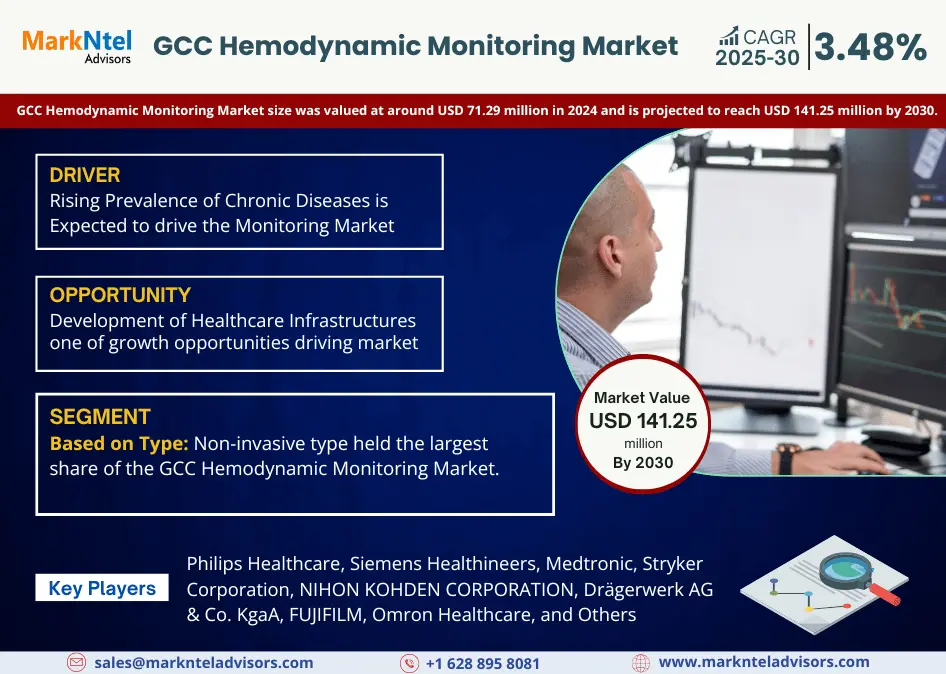Press Release Description
A USD 71.29 GCC Hemodynamic Monitoring Market to Grow at a Steady CAGR of Around 3.48% During 2025-30
The GCC Hemodynamic Monitoring Market size was valued at around USD 71.29 million in 2024 and is projected to reach USD 141.25 million by 2030. Along with this, the market is estimated to grow at a CAGR of about 3.48% during the forecast period i.e., 2025-30, cites MarkNtel Advisors in the recent research report. The GCC hemodynamic monitoring industry is growing considerably due to changes in lifestyle, the growing old population, and the increasing occurrence of cardiovascular illnesses.
Also, superior monitoring solutions are in greater call for mainly non-invasive ones that allow real-time data collection without the risks of invasive techniques. Supreme hemodynamic monitoring systems are being adopted as a result of notable investments in healthcare infrastructure made under strategies like the UAE Health Strategy and Saudi Arabia Vision 2030. Furthermore, the need for efficient monitoring is highlighted by the high prevalence of chronic diseases in the area particularly diabetes, respiratory disorders, and cardiovascular conditions. Nearly 40% of GCC adults suffer from excessive blood pressure and in countries like Bahrain, Kuwait, Saudi Arabia, and the United Arab Emirates weight problems charges surpass 70%.
Moreover, the expansion of hemodynamic tracking devices is being made possible by the enhancement of healthcare infrastructure. Saudi Arabia plans to invest more than USD 65 billion in healthcare equipment and enhance its regional participation. Similar to this the UAE is modernizing its medical equipment in line with its goal of bettering patient outcomes. Furthermore, the use of modern technologies like cloud computing, machine learning, and artificial intelligence (AI) is transforming hemodynamic monitoring technology. AI enhances data analytics enabling real-time insights and predictive analytics to anticipate important events. In medical settings, non-invasive techniques are gaining more notoriety because they provide protection and comfort to the afflicted person, further states the research report, “GCC Hemodynamic Monitoring Market Analysis, 2025.”

GCC Hemodynamic Monitoring Market Segmentation Analysis
Non-Invasive Type Holds the Largest Market Share
Based on the type, the market is further bifurcated into Invasive, Minimally Invasive, and Non-Invasive. In the GCC Hemodynamic Monitoring Market, the non-invasive segment is leading with nearly 40% of the marketplace. The developing preference for more secure and patient-friendly monitoring techniques that reduce the risk of complications from invasive procedures is a key driver of this trend. Moreover, non-invasive methods like wearable devices and superior imaging technology permit real-time data collection. In non-invasive methods, the discomfort and capability risks associated with traditional invasive techniques are removed. As healthcare providers place a greater emphasis on non-invasive options, particularly in settings like hospitals and home care, elevates the demand for it. Additionally, technological improvements that increase the accuracy and reliability of non-invasive monitoring are solidifying its function inside the marketplace.
Saudi Arabia Leads the GCC Hemodynamic Monitoring Industry
Saudi Arabia is dominating the geographical position by holding almost 50% of the market proportion within the GCC Hemodynamic Monitoring Market. The biggest member of the Gulf Cooperation Council, Saudi Arabia is taking numerous initiatives to enhance its healthcare system, elevating the hemodynamic monitoring industry growth. The rising number of hospitals and critical care centers ready with medical technology is part of those initiatives. The government's Vision 2030 program pursues to enhance healthcare investment for offerings and promote the development of medical technology. Moreover, there may be a growing need for effective hemodynamic monitoring systems due to Saudi Arabia's growing old-age population and cardiovascular disease occurrence. Saudi Arabia's big healthcare packages have made it the vicinity's largest market.
Competitive Landscape
With strategic initiatives, such as mergers, collaborations, and acquisitions, the leading market companies, including Philips Healthcare, Siemens Healthineers, Medtronic, Stryker Corporation, NIHON KOHDEN CORPORATION, Drägerwerk AG & Co. KgaA, FUJIFILM, Omron Healthcare, Honeywell, CardinalHealth, and Others are looking forward to strengthening their market positions.
Key Questions Answered in the Research Report
- What are the industry’s overall statistics or estimates (Overview, Size- By Value, Forecast Numbers, Segmentation, Shares)?
- What are the trends influencing the current scenario of the market?
- What key factors would propel and impede the industry across the region?
- How has the industry been evolving in terms of geography & product adoption?
- How has the competition been shaping up across the countries?
- How have buying behavior, customer inclination, and expectations from product manufacturers been evolving during 2020-2030?
- Who are the key competitors, and what strategic partnerships or ventures are they coming up with to stay afloat during the projected time frame?
We offer flexible licensing options to cater to varying organizational needs. Choose the pricing pack that best suits your requirements:
Buy NowNeed Assistance?
WRITE AN EMAIL
sales@marknteladvisors.comCustomization Offered
100% Safe & Secure
Strongest encryption on the website to make your purchase safe and secure
